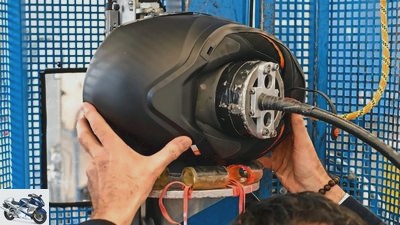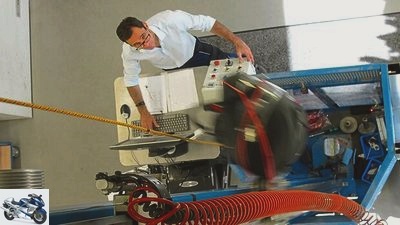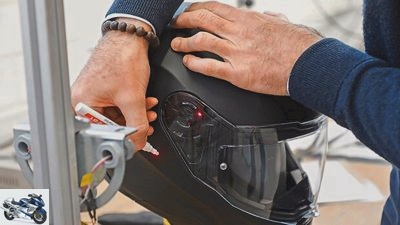Table of contents
- Helmet standard ECE 22.06 New rules for even more security
- Stricter test requirements
- Visors have to be more resistant
- Interview with TuV expert
- opinion poll
- Conclusion

Markus Jahn
counselor
traffic & business
Helmet standard ECE 22.06: New rules for even more safety
Helmet standard ECE 22.06
New rules for even more security
After a good 20 years, the safety standard for motorcycle helmets is being reformed. Helmets can be tested according to the new ECE-R-22.06 since the beginning of 2021. From June 3, 2022, tests will only be carried out according to the new standard.
Uli Baumann,
Klaus Herder
04/26/2021
The ECE regulation 22 of the United Nations regulates which requirements motorcycle helmets must meet in order to be approved for road traffic. ECE 22.05 has been in force for almost twenty years and is being replaced by the reformed regulation ECE 22.06. It has been possible to test helmets according to the new standard since the beginning of 2021. From June 2022, tests will only be carried out according to the new standard. From June 2023, helmets with the ECE 22.05 standard will no longer be allowed to be produced. Their sale can then be banned from the beginning of 2024. The new ECE 22.06 is primarily intended to make helmets and visors, as prescribed for use on motorized two-wheelers, even safer. Helmets that have been tested according to ECE 22.05 can of course continue to be used. There is no obligation to exchange. When purchasing a new one, you should of course pay attention to the latest test standard.
Stricter test requirements
And what is changing? As the FEMA (Federation of European Motorcyclists ’Associations) reports, the new standard primarily describes changes in the test procedure for helmets. Tests are generally carried out at a higher impact speed, and the testers are now free to choose the point of impact. This was predefined beforehand, so manufacturers had partly optimized their helmets accordingly.

Klaus Herder
Modular helmets (for example, flip-up helmets and open face helmets with a flanged chin section) will be tested with and without chin protection or chin section in the future. The integrated sun visors, which are now very common, are also being examined more closely. The sun visors must be able to be moved independently of the visor. If sun protection is integrated, it must be folded down for testing. The same applies to accessories. Only the add-on parts installed during the test may later be found on the series helmet. If changes are made, the helmet must be checked with the new attachments. Otherwise the type approval will expire. So far, it remains to be seen how add-on parts, for example for action cams or communication systems, will behave. However, this field has been a gray area up to now. Experts assume, however, that there will be no restrictions as long as these parts are not firmly connected to the helmet shell and can thus become detached in the event of an impact.
Visors have to be more resistant
The demands on the visors and their mechanics are also increased. They have to withstand the impact of a steel test ball at a speed of 60 m / s without bursting. The visor mechanism must also defy the forces. An impact test method for measuring the rotational acceleration is also added to the test procedure.

Markus Jahn
Depending on other national requirements, the new helmets must have reflective surfaces or, alternatively, reflective stickers. These can also be enclosed with the helmet together with a corresponding assembly instruction.
Interview with TuV expert
Peter Schaudt (57) from TuV Rheinland in Cologne has been the MOTORRAD contact for many years when it comes to bench tests as part of helmet tests. in the “normal” He examines daily business, among other things. for the most varied of helmet manufacturers, whether their products (in addition to motorcycle helmets, e.g. also bicycle and rider helmets) comply with the applicable ECE standards. MOTORRAD editor Klaus Herder asked him about the effects of the change from the ECE-R 22.5, which has been in effect for 19 years (!) To the new ECE-R 22.06.
What is your official job title at TuV Rheinland? How long have you been in the helmet testing business??
Shudders: As for the helmets: Expert technical service. Otherwise I am an officially recognized expert for motor vehicle traffic. I have been responsible for the helmet test since 2001.
Why was the ECE-R 22.05 long in need of overhaul?
Shudders: Like every standard, the 22.05 must also be adapted to the requirements. These can be technical requirements, such as B. new materials. The test temperature for the cold helmets is now minus ten instead of minus 20 degrees. B. only EPS (Styrofoam). An adjustment may also be necessary due to new findings from the accident. Hence the introduction of the rotation test or the helmet removal test in both directions. We have certainly all experienced the need for the latter, a helmet can be pushed back without any effort. This is no longer permissible. In addition to the increased security, there is also an improvement in comfort because the chinstrap lock is no longer on the larynx.
In what form were you or TuV Rheinland involved in the design of ECE-R 22.06?
Shudders: The process of changing a UN regulation is very broad and lengthy because all states (CP) that signed the 1958 UNECE agreement have a say. There are currently 64 states (of which 47 states apply the regulation on their territory). Non-governmental organizations (NGOs) are also involved in the consultations. As a consultant to the Federal Ministry of Transport and Digital Infrastructure, TuV Rheinland is constantly represented by an employee in the relevant meetings. If necessary, this colleague will then be supported by the specialists from TuV Rheinland. I’m one of those in the case of UN-R 22.
Since when has the ECE-R 22.06 been in effect, what is the future schedule??
Shudders: ECE-R-22.06 approvals or supplements can be issued since 03/01/2021. From June 3, 2022, only ECE-R-22.06 approvals will be issued. From June 3, 2023, the approval mark according to ECE-R 22.05 may no longer be affixed (production ban). From 03/01/2024, the sale of ECE-R-22.05-approved helmets can be prohibited.
What are the main differences to ECE-R 22.05?
Shudders: The main factors are the changed test temperature in the cold, additional lower or higher impact speed (6 m / s or 8.2 m / s). The technical service can also select test points. This means that a specific design of helmets based on the existing test points is basically no longer possible. Other differences: Introduction of the rotation test. Extension of the helmet stripping test, to the front as usual, now also to the rear. Gunfire testing of visors. The inspection of the sun visors was added. So far nothing has been checked, which in part meant that traffic light colors could not be recognized; Red or green appeared in gray!
How do the changes actually affect the daily testing process??
Shudders: The testing process is much more extensive. An example: For a helmet that is offered in two shell sizes, 17 helmets have to be tested for the basic approval; according to ECE-R 22.06, 33 samples are required.
What are the advantages and disadvantages of ECE-R 22.06 for a) the end user?
Shudders: First of all, the helmets will probably be more expensive, and existing constructions can no longer be easily accessed.
b) the helmet manufacturers?
Shudders: The model selection will inevitably be smaller, new designs are very expensive.
c) the testing organizations?
Shudders: Due to the larger number of test samples, the test times are longer, I don’t see any longer approval times from authorities.
What else would helmet professional Peter Schaudt (or TuV Rheinland …) have wished for, what could possibly have been dispensable?
Shudders: The standard that has now finally been achieved is a good compromise for the basis of better protective helmets. Now it remains to be seen whether this is also reflected in the number of accidents. If necessary, you should refuel quickly and you shouldn’t let another 19 years pass.
How have the helmet manufacturers react to the new regulations so far??
Shudders: The number of tests is currently very high, and manufacturers want to see where their product is. The smaller providers will probably wait and see how the market develops.
Keyword rotation: What practical experience has there been in previous testing?
Shudders: With the helmets we have tested so far, there have been no nasty surprises. No design changes would be required for the helmets if the rotation limits remained as they are.
Is ECE-R 22.06 fixed in its present form, or is there still a need for improvement? If so, which one?
Shudders: The standard has to adapt to the circumstances, a discussion about limit values or the interpretation of test procedures has to take place continuously.
Your conclusion: real improvement or just manageable cosmetics?
Shudders: The ECE-R 22.06 is a real improvement!
opinion poll
Which manufacturer did your helmet come from??
Voted 20840 times
HJC
Shoei
Nolan / X-Lite
Schuberth
Shark
Scorpion
Arai
AGV
LS2
Airoh
Caberg
Icon
Marushin
Different manufacturer
Conclusion
After more than 19 years there is a new test standard for motorcycle helmets. The ECE-R 22.06 makes helmets even safer.
Related articles
-
Motorcycle helmet purchase advice: What to look out for when buying a helmet
MIPS 10 pictures MIPS 1/10 Researchers and studies have linked severe brain injuries, as well as minor injuries such as concussions, to rotational…
-
Motorcycle helmets: test, purchase advice, ECE standard, communication
Herder 14th pictures Herder 1/14 Jorg Lohse trying in vain to mount a wind deflector on the X-lite. Can you test harder? no! Herder 2/14 The Schuberth S1…
-
Ten years of standard for protectors
2snap clothing Ten years of standard for protectors Ten years of standard for protectors The party fright For a decade there has been a standard…
-
Bilski clothing Helmets Big helmet test 2005 Big helmet test 2005 Strong arguments Not all helmets are the same? even if the models hardly differ from…
-
Frog helmet holder – small, light and award-winning
Frog 24 pictures Frog 1/24 The idea for the Frog helmet holder came up six years ago. Frog 2/24 The team from Barcelona worked on the perfect shape and…
-
Helmet provider in the service test
mps photo studio 4th pictures mps photo studio 1/4 Exciting question: Will the manufacturers find the fault?? mps photo studio 2/4 Suddenly a small but…
-
LS2 FF397 Vector full-face helmet in the test
mps studio clothing Helmets LS2 FF397 Vector full-face helmet in the test LS2 FF397 Vector in the test Comparison test full face helmets (MOTORRAD…
-
A tour of the helmet manufacturer in Italy
Dentges 8th pictures Dentges 1/8 Matter of the mind: There are specially stored injection molds for each helmet model. Dentges 2/8 Mr. Robot’s helping…
-
Arai RX-7V: CBR helmet in Fireblade look
Arai. 6th pictures Arai. 1/6 The Arai RX-7V is now also available in the Honda CBR look. Arai. 2/6 There are three different designs available. Shown…
-
iC-R: Smart helmet with camera surveillance
Intelligent Cranium Helmets 8th pictures Intelligent Cranium Helmets 1/8 Another smart helmet comes from the USA, which makes it easier for the wearer to…